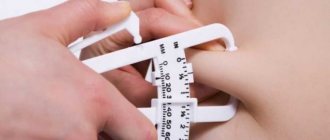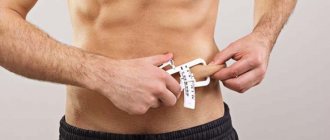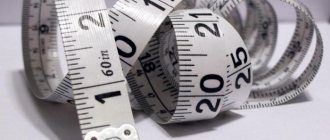How to measure?
Stand up straight, straighten your back. Grab the fold of skin and fat just below the navel horizontally - thumb on top, index finger on bottom. Place the ruler horizontally, resting its end on the stomach, and measure the thickness of the fold in millimeters. Then find the resulting value in the table below based on your age. The content of adipose tissue in the body of women (in percent)
| Subcutaneous fat fold, mm | 18-29 years old | 30-39 years old | 40-49 years old | 50 or more years |
| 15 | 10,5 | — | — | — |
| 20 | 14,1 | 17 | 19,8 | 21,4 |
| 25 | 16,8 | 19,4 | 22,2 | 24 |
| 30 | 19,5 | 21,8 | 24,5 | 26,6 |
| 35 | 21,5 | 23,7 | 26,4 | 28,5 |
| 40 | 23,4 | 25,5 | 26,2 | 30,3 |
| 45 | 25 | 26,9 | 29,6 | 31,9 |
| 50 | 26,5 | 28,2 | 31 | 33,4 |
| 55 | 27,8 | 29,4 | 32,1 | 34,6 |
| 60 | 29,1 | 30,6 | 33,2 | 35,7 |
| 65 | 30,2 | 31,6 | 34,1 | 36,7 |
| 70 | 31,2 | 32,5 | 35 | 37,7 |
| 75 | 32,2 | 33,4 | 35,9 | 38,7 |
| 80 | 33,1 | 34,3 | 36,7 | 39,6 |
| 85 | 34 | 35,1 | 37,5 | 40,4 |
| 90 | 34,6 | 35,8 | 38,1 | 41,2 |
| 95 | 35,6 | 36,5 | 39 | 41,9 |
| 100 | 36,4 | 37,2 | 39,7 | 42,6 |
| 105 | 37,1 | 37,9 | 40,4 | 43,3 |
| 110 | 37,8 | 38,6 | 41 | 43,9 |
| 115 | 38,4 | 39,1 | 41,5 | 44,5 |
| 120 | 39 | 39,6 | 42 | 45,1 |
| 125 | 39,6 | 40,1 | 42,5 | 45,7 |
| 130 | 40,2 | 40,6 | 43 | 46,2 |
| 135 | 40,8 | 41,1 | 43,5 | 46,7 |
| 140 | 41,3 | 41,6 | 44 | 47,2 |
| 145 | 41,8 | 42,1 | 44,5 | 47,7 |
| 150 | 42,3 | 42,6 | 45 | 48,2 |
| 155 | 42,8 | 43,1 | 45,4 | 48,7 |
| 160 | 43,3 | 43,6 | 45,8 | 49,2 |
| 165 | 43,7 | 44 | 46,2 | 49,6 |
| 170 | 44,1 | 44,4 | 46,6 | 50 |
| 175 | 44,4 | 44,8 | 47 | 50,4 |
| 180 | 44,7 | 45,2 | 47,4 | 50,8 |
| 185 | 45 | 45,6 | 47,8 | 51,2 |
| 190 | 45,3 | 45,9 | 48,2 | 51,6 |
| 195 | 45,5 | 46,2 | 48,5 | 52 |
| 200 | 45,5 | 46,5 | 48,8 | 52,4 |
| 205 | 45,8 | 46,8 | 49,1 | 52,7 |
| 210 | 46 | 47,1 | 49,4 | 53 |
Content of adipose tissue in the body of men (in percent)
| Subcutaneous fat fold, mm | 18-29 years old | 30-39 years old | 40-49 years old | 50 or more years |
| 15 | 4,8 | — | — | — |
| 20 | 8,1 | 12,2 | 12,2 | 12,6 |
| 25 | 10,5 | 14,2 | 15 | 15,6 |
| 30 | 12,9 | 16,2 | 17,7 | 18,6 |
| 35 | 14,7 | 17,7 | 19,6 | 20,8 |
| 40 | 16,4 | 19,2 | 21,4 | 22,9 |
| 45 | 17,7 | 20,4 | 23 | 24,7 |
| 50 | 19 | 21,5 | 24,6 | 26,5 |
| 55 | 20,1 | 22,5 | 25,9 | 27,9 |
| 60 | 21,2 | 23,5 | 27,1 | 29,2 |
| 65 | 22,2 | 24,3 | 28,2 | 30,4 |
| 70 | 23,1 | 25,1 | 29,3 | 31,6 |
| 75 | 24 | 25,9 | 30,3 | 32,7 |
| 80 | 24,8 | 26,6 | 31,2 | 33,8 |
| 85 | 25,5 | 27,2 | 32,1 | 34,8 |
| 90 | 26,2 | 27,8 | 33 | 35,8 |
| 95 | 26,9 | 28,4 | 33,7 | 36,6 |
| 100 | 27,6 | 29 | 34,4 | 37,4 |
| 105 | 28,2 | 29,6 | 35,1 | 38,2 |
| 110 | 28,8 | 30,1 | 35,8 | 39 |
| 115 | 29,4 | 30,6 | 36,4 | 39,7 |
| 120 | 30 | 31,1 | 37 | 40,4 |
| 125 | 30,5 | 31,5 | 37,6 | 41,1 |
| 130 | 31 | 31,9 | 38,2 | 41,8 |
| 135 | 31,5 | 32,3 | 38,7 | 42,4 |
| 140 | 32 | 32,7 | 39,2 | 43 |
| 145 | 32,5 | 33,1 | 39,7 | 43,6 |
| 150 | 32,9 | 33,5 | 40,2 | 44,1 |
| 155 | 33,3 | 33,9 | 40,7 | 44,6 |
| 160 | 33,7 | 34,3 | 41,2 | 45,1 |
| 165 | 33,7 | 34,6 | 41,6 | 45,6 |
| 170 | 34,5 | 34,8 | 42 | 46,1 |
| 175 | 34,9 | 35 | 42,4 | 46,5 |
| 180 | 35 | 35,2 | 42,8 | 46,9 |
| 185 | 35,6 | 35,4 | 43 | 47,3 |
| 190 | 35,9 | 35,6 | 43,3 | 47,7 |
How to measure your body fat percentage at home?
You can calculate the percentage of body fat at home. These measurement methods are less accurate and only measure subcutaneous fat.
- Visual. To find out the amount of fat, you need to compare your figure with photographs presented on sports sites. This is one of the most unreliable measurement methods.
- An online calculator is a quick method that does not require complex calculations, but the calculations are most often not accurate.
- By body mass index. This measurement method is only suitable for beginners in the sport.
- Scales with analyzer. This device works on the principle of bioimpedancemetry, when a weak electric current is passed through the body. This method of measurement is quite accurate provided that the weighings are carried out under the correct conditions.
- Using a caliper - a special device that measures the thickness of the body fold. The most accurate way to measure at home. If such a device is not at hand, then you can measure the percentage of fat using a caliper or an adjustable wrench. To determine the percentage of fat, you need to take several measurements: on the stomach to the right of the navel, in the middle of the forearm from the biceps and triceps, on the shoulder blade. To do this, grab the fold with your fingers, pull it back and measure its thickness with a caliper. The results obtained are added up and checked against the data in the table. Measurements using a caliper give results with an error of 3-5%.
Subcutaneous fat content (%) in women:
| Age | Fold thickness (mm) | |||||||||||||||
| 2-3 | 4-5 | 6-7 | 8-9 | 10-11 | 12-13 | 14-15 | 16-17 | 18-19 | 20-21 | 22-23 | 24-25 | 26-27 | 28-29 | 30-31 | 32-33 | |
| 18-20 | 11,3 | 13,5 | 15,7 | 17,7 | 19,7 | 21,5 | 23,2 | 24,8 | 26,3 | 27,7 | 29 | 30,2 | 31,3 | 32,3 | 33,1 | 33,9 |
| 21-25 | 11,9 | 14,2 | 16,3 | 18,4 | 20,3 | 22,1 | 23,8 | 25,5 | 27 | 28,4 | 29,6 | 30,8 | 31,9 | 32,9 | 33,8 | 34,5 |
| 26-30 | 12,5 | 14,8 | 16,9 | 19 | 20,9 | 22,7 | 24,5 | 26,1 | 27,6 | 29 | 30,3 | 31,5 | 32,5 | 33,5 | 34,4 | 35,2 |
| 31-35 | 13,2 | 15,4 | 17,6 | 19,6 | 21,5 | 23,4 | 25,1 | 26,7 | 28,2 | 29,6 | 30,9 | 32,1 | 33,2 | 34,1 | 35 | 35,8 |
| 36-40 | 13,8 | 16 | 18,2 | 20,2 | 22,2 | 24 | 25,7 | 27,3 | 28,8 | 30,2 | 31,5 | 32,7 | 33,8 | 34,8 | 35,6 | 36,4 |
| 41-45 | 14,4 | 16,7 | 18,8 | 20,8 | 22,8 | 24,6 | 26,3 | 27,9 | 29,4 | 30,8 | 32,1 | 33,3 | 34,4 | 35,4 | 36,3 | 37 |
| 46-50 | 15 | 17,3 | 19,4 | 21,5 | 23,4 | 25,2 | 26,9 | 28,6 | 30,1 | 31,5 | 32,8 | 34 | 35 | 36 | 36,9 | 37,6 |
| 51-55 | 15,6 | 19,7 | 20 | 22,1 | 24 | 25,9 | 27,6 | 29,2 | 30,7 | 32,1 | 33,4 | 34,6 | 35,6 | 36,6 | 37,5 | 38,3 |
| 56+ | 16,3 | 18,5 | 20,7 | 22,7 | 24,6 | 26,5 | 28,2 | 29,8 | 31,3 | 32,7 | 34 | 35,2 | 36,3 | 37,2 | 38,1 | 38,9 |
Subcutaneous fat content (%) in men:
| Age | Fold thickness (mm) | |||||||||||||||
| 2-3 | 4-5 | 6-7 | 8-9 | 10-11 | 12-13 | 14-15 | 16-17 | 18-19 | 20-21 | 22-23 | 24-25 | 26-27 | 28-29 | 30-31 | 32-33 | |
| 18-20 | 2 | 3,9 | 6,2 | 8,5 | 10,5 | 12,5 | 14,3 | 16 | 17,5 | 18,9 | 20,2 | 21,3 | 22,3 | 23,1 | 23,8 | 24,3 |
| 21-25 | 2,5 | 4,9 | 7,3 | 9,5 | 11,6 | 13,6 | 15,4 | 17 | 18,6 | 20 | 21,2 | 22,3 | 23,3 | 24,2 | 24,9 | 25,4 |
| 26-30 | 3,5 | 6 | 8,4 | 10,6 | 12,7 | 14,6 | 16,4 | 18,1 | 19,6 | 21 | 22,3 | 23,4 | 24,4 | 25,2 | 25,9 | 26,5 |
| 31-35 | 4,5 | 7,1 | 9,4 | 11,7 | 13,7 | 15,7 | 17,5 | 19,2 | 20,7 | 22,1 | 23,4 | 24,5 | 25,5 | 26,3 | 27 | 27,5 |
| 36-40 | 5,6 | 8,1 | 10,5 | 12,7 | 14,8 | 16,8 | 18,6 | 20,2 | 21,8 | 23,2 | 24,4 | 25,6 | 26,5 | 27,4 | 28,1 | 28,6 |
| 41-45 | 6,7 | 9,2 | 11,5 | 13,8 | 15,9 | 17,8 | 19,6 | 21,3 | 22,8 | 24,7 | 25,5 | 26,6 | 27,6 | 28,4 | 29,1 | 29,7 |
| 46-50 | 7,7 | 10,2 | 12,6 | 14,8 | 16,9 | 18,9 | 20,7 | 22,4 | 23,9 | 25,3 | 26,6 | 27,7 | 28,7 | 29,5 | 30,2 | 30,7 |
| 51-55 | 8,8 | 11,3 | 13,7 | 15,9 | 18 | 20,2 | 21,8 | 23,4 | 25 | 26,4 | 27,6 | 28,7 | 29,7 | 30,6 | 31,2 | 31,8 |
| 56+ | 9,9 | 12,4 | 14,7 | 17 | 19,1 | 21 | 22,8 | 24,5 | 26 | 27,4 | 28,7 | 29,8 | 30,8 | 31,6 | 32,3 | 32,9 |
As mentioned above, home methods can only measure the amount of subcutaneous fat layer. The presence of visceral fat can be calculated visually or using a measuring tape. If, with a normal physique and body mass index, a person has a large belly, and the waist circumference is more than 90 cm in men and 80 cm in women, then this indicates the presence of fatty formations on the internal organs.
When is the method useful?
Typically, healthy weight limits are calculated using the body mass index
(BMI) formula.
But the resulting value does not always reflect the real picture. An increased BMI can be observed in people with developed muscles, while a normal BMI can be observed in an unathletic person with a fragile physique and decent fat reserves. To more accurately determine your condition, it is better to evaluate two indicators at once
- BMI and body fat percentage.
For example, if, with a decrease in BMI, the percentage of fat remains unchanged, weight loss occurs due to a decrease in muscle mass, which can be called exhaustion of the body. If BMI increases, a change in the percentage of fat will show whether the weight is increasing - muscle mass is growing, or fat reserves are being deposited. According to Korochkin, this method of calculation is suitable for those who regularly train to lose weight. In this situation, it is not the exact knowledge of weight, BMI and body fat percentage that is important, but the change in these values over time
.
“Even if there is an error in the table or your measurements,” notes Korochkin, “the dynamics of changes in values will show whether you are moving in the right direction.”
Professional ways to measure body fat percentage
Body fat can be measured using special clinical equipment. Such methods help to find out not only the percentage of body fat, but also the amount of muscle in the human body.
- Bioimpedancemetry is a research method in which a weak electric current is passed through body tissue. This test can measure fat and muscle percentage, basal metabolic rate, water content, bone mass, and visceral (internal) fat.
- Underwater weighing. One of the most difficult measurement methods. To measure fat, regular weighing and underwater weighing are carried out, after which these indicators are compared and the amount of fat is calculated. It is considered one of the more reliable methods for calculating the amount of fat.
- Using the Bod Pod system. This is a special device that measures the air displaced by the body and, based on the data obtained, the volume, density and composition of the body are calculated. Like underwater weighing, it gives very accurate results, but has a high cost.
- X-ray examination helps to measure not only body fat, but also other important indicators: the amount of water and muscle in the body, the presence of internal fat and others.
With the help of professional research methods, you can find out the exact composition of your body. However, the cost of such studies makes them unaffordable for most people.
How to estimate your body fat percentage
Relative content of adipose tissue in the body of women (in percent)
| Characteristic | Age, years | ||||
| 18-29 | 30-39 | 40-49 | 50-59 | >60 | |
| Very low | |||||
| Low | 16-19 | 17-20 | 18-21 | 19-22 | 20-23 |
| Optimal | 20-28 | 21-29 | 22-30 | 23-31 | 24-32 |
| Moderate high | 29-31 | 30-32 | 31-33 | 32-33 | 33-35 |
How to lose weight through sports?
Basic rules of training, diet and useful links in the material for those who want to learn how to lose weight correctly and reliably.
Relative content of adipose tissue in the body of men (in percent)
| Characteristic | Age, years | ||||
| 18-29 | 30-39 | 40-49 | 50-59 | >60 | |
| Very low | |||||
| Low | 11-13 | 12-14 | 14-16 | 15-17 | 16-18 |
| Optimal | 14-20 | 15-21 | 17-23 | 18-24 | 19-25 |
| Moderate high | 21-23 | 22-24 | 22-26 | 25-27 | 26-28 |
If there is too little fat?
A reduced body fat content is not a reason for pride, but a reason for reviewing your diet.
Lack of adipose tissue in the body disrupts the functioning of the endocrine system. In this case, women may stop menstruating and experience early signs of osteoporosis, a disease in which bones lose calcium and become very fragile. In addition, if the fat layer in the lower back and hips completely disappears, the kidneys and organs of the reproductive system are deprived of protection from the cold. When hypothermia occurs, a woman runs the risk of developing inflammatory processes in the pelvic organs. Myths about losing weight
Are there products to burn fat in specific areas? Is it possible to lose weight quickly and effectively? What do the scales show before and after training? Let's talk.
If there is too much fat?
Too much body fat indicates an increased risk of developing cardiovascular diseases and metabolic diseases, such as hypertension and type 2 diabetes. Particularly dangerous for both men and women is the so-called abdominal obesity - the deposition of fat reserves in the waist area. It increases the risk of developing cardiovascular disease by five times. A real cause for alarm appears when the waist circumference in men exceeds 102, and in women - 88 centimeters.
Calculate BMI for women by age
The BMI counter shows the result according to the basic or advanced classification of adults. The first distinguishes between four different weight ratings, and the advanced also distinguishes between three degrees of underweight and three degrees of obesity:
- underweight (<8.5) – underweight (less than 18.5), wasting (less than 17), fasting (less than 16),
- correct value (18.5-24.9),
- overweight (25-29.9),
- obesity (≥30) – 1st degree obesity (up to 34.9), 2nd degree obesity (up to 39.9), 3rd degree obesity (more than 40).
Due to the growing problem of obesity as a disease of civilization, it has also been proposed to create a detailed division of obesity that would include as many as 10 categories. In this classification, obesity degree X will be the highest with an index of 100 or more. This broad BMI scale is a way to more accurately determine the risk of complications and plan treatment for people with morbid obesity.
The level of overweight or underweight can also be calculated using a modified body mass index - BMI Prime.
- It is calculated by dividing a person's BMI by the upper limit of normal BMI, which is 25. If the resulting number is between 0.74 and 1, the weight is normal.
- A value below 0.74 indicates underweight, above 1 indicates overweight.
- The BMI Prime indicator allows, for example, a doctor to clearly show the problem of excess weight in a patient and quickly calculate how many kilograms he needs to lose in order for his weight to return to normal.
BMI - age
The older we get, the more our muscle mass and bone mass decrease. In this case, the amount of adipose tissue most often increases. Please note that BMI does not record your body's aging process. Therefore, BMI results in older people are often misinterpreted as being better than they actually are.
You should always be sure that you interpret the result obtained from the BMI calculator correctly.
BMI index and muscle and bone mass
Many people wonder what the correct BMI should be.
Muscle is dense and much heavier than fat. It is not surprising that often two people with the same body weight look completely different in appearance. This has to do with the ratio of muscle mass to fat. Of course, if BMI is calculated for women by age, it does not take these differences into account. Contrary to appearances, well-built people who exercise regularly are often classified as overweight or even obese.
According to the BMI index, they are at risk of diabetes and heart disease, which, of course, is not true, because it is thanks to large muscle mass and an active lifestyle that unwanted diseases can be avoided. Another factor that influences our body weight is the degree of mineralization and bone density.
The correct body weight will be completely different for people who are short and big-boned. In addition, BMI does not take into account the fact that bone density decreases with age, and older people often suffer from osteoporosis, which reduces their body weight.
Obesity degree other indicators
The BMI index, popular mainly due to its ease of calculation, has its disadvantages and limitations. It is designed for the average adult without gender differences.
- BMI does not measure the proportion of fat in the body, as well as muscle, bone and water.
- It also does not take into account the distribution of this tissue and therefore the type of obesity (abdominal obesity versus femorofemoral obesity), which research suggests plays the most important role in assessing the risk of diseases associated with this disease.
For this reason, using a BMI calculator, for example on athletes and physically active people with extensive muscle tissue, may lead to erroneous conclusions. The BMI calculator is also not applicable to pregnant and lactating women, the elderly and children.
Nutrition for obesity: Eating with excess weight - how to bring the body back to normal
How to estimate the amount of fat in the body. Tomography, resonance and DXA
The amount of adipose tissue can be accurately determined using various methods. These include:
- computed tomography (CT);
- magnetic resonance (MR), examination;
- X-ray dual energy absorption (DXA).
Due to the limited availability of specialized equipment and high costs, these tests are very rarely performed in practice.
Obesity degree by measuring the thickness of skin folds - electrical bioimpedance (BIA)
Measuring skin thickness is performed much more frequently, and more recently the bioimpedance assessment (BIA) technique has been used.
This is a non-invasive method for studying body composition, which consists of measuring the electrical resistance of soft tissue through which a low-intensity current passes.
The portable equipment used for this is relatively inexpensive and easy to use, so it can be found in doctors' offices, diet clinics, or even health clubs.
Obesity degree according to BMI indicator WHR
A tool to easily assess the type of obesity most of us have at home. This is a tailor's centimeter, thanks to which we will measure the waist circumference and determine the WHR (waist-hip ratio), which determines the ratio of the waist length to the hip circumference.
- If a woman has ≥ 0.8 and a man ≥ 1.0, she has abdominal obesity (internal organs, or visceral obesity).
- Lower WHR scores indicate gluteal-femoral obesity (also called gynoid obesity).
To find out and correctly calculate BMI for women by age, whether our weight is within the normal range and what type of obesity we are prone to according to BMI, it is worth calculating the BMI index and the WHR index. If their values are of concern, a more detailed assessment of body composition, including body fat content and distribution, is recommended.
There is also a lot of important information on the issue:
Quick diets for losing weight by 10 kg in a week at home
Abdominal obesity in men risk factors
The most effective anti-obesity drugs
Protein-free diet for kidney disease











